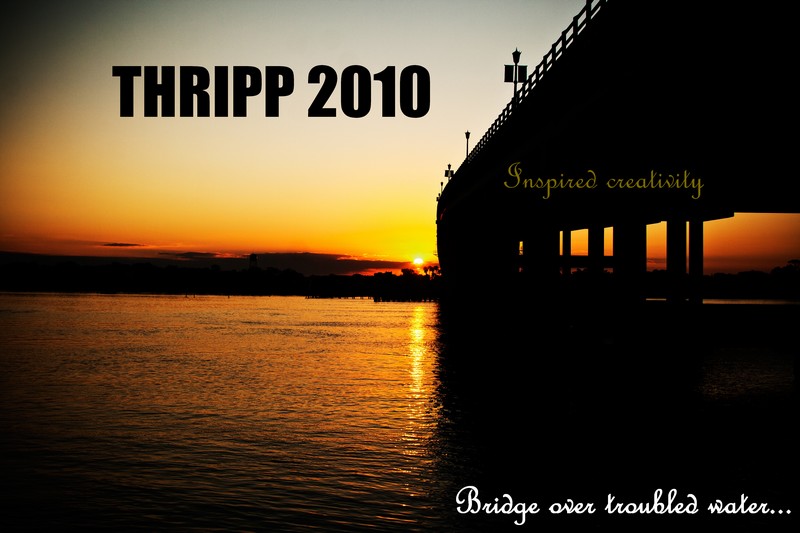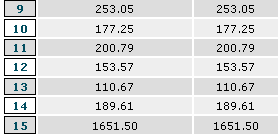Richard X. Thripp in QUANTA.
Essays by Richard X. Thripp.
2008-07-17 — http://richardxthripp.thripp.com/essays
PDF version (100 KB).
Two introspective essays I wrote in December of 2007 and May of 2008, for completing the Fall and Spring semesters in the QUANTA learning community (daytonastate.edu/quanta) at Daytona Beach College. I can’t look at these and say they speak for me now, because they speak for the Richard X. Thripp of 2007-12 and 2008-05, from which I’m constantly changing. They’re a good representation of QUANTA and elaborate on some of my beliefs, though.
The Learning Community: Reflections on Sixteen Weeks in QUANTA [2007-12-10]
For the sixteen weeks of the fall 2007 semester, the QUANTA learning community at Daytona Beach College has been my second home. Meeting for three hours, three times a week, we tackle issues ranging from the smallest details of MLA formatting, to questions perpetual to the human condition, such as in my group’s most recent presentation, “does the individual really make a difference?” (we say yes, but to a fault). Being a large class, we are broken up into nine groups at the start of the semester, in which each of us is forced to either work together with our colleagues, or perish. It is this collectivism that makes QUANTA special—in no other class would we get to do exams on our own and then as a group, and it is in the latter that concepts in my mind are solidified, for it is David, Heather, Katie, and Lillie’s succinct explanations of sociological terms such as alienation and assimilation that are most memorable. We are also quite good friends now, unlike in normal courses which you can be in for months without knowing anyone. It is collaboration and the community spirit that defines QUANTA, and combined with unique assignments such as our scavenger hunt around the campus, field trip to DeLeon Springs, and playing amateur psychologist to analyze our classmates sleeping dreams, I learn more effectively and am always looking forward to our next class. Before QUANTA I preferred to not work with others, but I have found that by combining my knowledge with that of the other members of my group, we leave no topic ignored, no question unanswered, and no challenge undefeated. At the book seminars, we all pitch in with our analysis of the stories, in our planning for the Celebration of the Creative Spirit presentation, we all worked on the script and brought props and beverages, and in our group exams for sociology and humanities, we reached consensus on the questions and exceeded our individual aptitude.
In the essays and informal writing assignments alike, there is no mercy for the faint of heart. Regurgitated summaries of works such as The Epic of Gilgamesh and The Canterbury Tales will not suffice: what is expected is thorough and thoughtful analysis of the intentions of the authors and characters, substantiated with quotes and examples. When I first flipped through my copy of the QUANTA handbook, I thought the workload was moderate, but it is actually far higher, as Blanton, Gunshanan, and Flota value quality writing over quantity of output. We are encouraged to read critically, by first responding, then understanding and evaluating. This is no small task: for Antigone, for example, I produced enough notes and highlighting to fill four pages, before even finishing the reading process, and soon enough I was re-reading the work twice to understand and holistically evaluate the message and characters. All this is needed to write a polished and persuasive essay, and through my professors’ challenging assignments my writing and comprehension have markedly improved, preparing me for the years of college and professional world ahead.
I often found myself applying sociological concepts to my humanities studies—such as social stratification and anomie contributing to the Roman Empire’s demise. In a normal set of firewalled courses, I would not connect concepts together as such, but with the topics weaved together as in QUANTA, the lessons are interesting and clear. Michael Flota’s lectures are energetic and engaging. The topic of sociology has been enjoyable because I am looking at society and how others behave much more closely now, and it has given me the big picture of why crime, wars, hatred, and inequity persists. I also learned that we Americans are the most unequal country of all, with the one percent at the top claiming more of the wealth than our poorest forty percent; perhaps we are not such a fair society as we think? Such curiosity is encouraged in QUANTA.
Casey Blanton’s lessons in history and the humanities are interesting and informative; the histories of Christianity, Islam, and Judaism were most interesting to me, as the trio seems completely separate, but in fact each originated similarly and involves many of the same characters, such as Abraham, considered the father of the peoples of all three. I am looking forward to learning of the Renaissance and later periods in the next semester, and enjoyed our creative assignments this term, particularly the third exam, in which I made a small illuminated manuscript of a biblical scripture enumerating the virtues of love, and the humanities observation project, in which I saw and wrote about nearby Daytona Beach College Theater Center’s play, Cat on a Hot Tin Roof.
Frank Gunshanan is a thoroughly tough English teacher, but the most fair of all—he finds the time to read everything I write most carefully, producing no shortage of criticisms and praise in the margins. “Show—don’t tell” is the concept that helped me the most. I find myself framing my essays with quotes, facts, and examples out of habit, such as mentioning the 1960s civil rights movement as a tipping point against inequality, and quoting twelve sources in my research paper, which I use to argue that it is unethical to use implicit-association testing in employment screening. I liked that paper the most, as I got a chance to pick a topic that interests me, and then scour the library and Internet for scholarly articles and opinions to base my essay on.
I have been very happy to start my collegiate education in this course, as it has been a great introduction to the rigors of post-secondary education. Working in a classroom environment, after a decade of being taught at home by my father, I find that studying and communicating in groups is my most lacking skill, but fortunately, there is no better place than QUANTA to become a fledgling diplomat. The professors are the most dedicated around—I could easily tell that Casey knows how learning communities best work with her twenty years leading the group, and Frank and Michael are finally putting their brilliant knowledge of grammar and exchange mobility to use as part of the family. The fun is only half over; I am excited to continue the subjects in the spring semester, taking advantage of all the opportunities QUANTA offers.
A Lifetime of QUANTA [2008-05-05]
In the twenty-first century, what will be most important is the access to information—it should be organized, honed, and easily searched. This is especially evident in the CPP globalization group’s video, where we learned that the publication of books and web pages is growing at an exponential rate. This rate of growth, driven by consumer-generated content, is far ahead of our ability to digest such information; it must be culled to the core, most relevant bits. While search engines like Google may attempt to catalog everything we need to know, it will always be admist a sea of noise and clutter, and they miss much of the best and most thoroughly researched information, which will continue to be found in print. This is why public libraries, staffed by knowledgeable and resourceful scholars, serve an essential place in our communities. Their purpose is not only to offer a catalog of knowledge, but the help to find it, be it a popular video release that the patron only recalls fuzzy details of, or details on the habitat of the great white sharks. I once had a person come into my library wanting that, but he started out asking for a book on sea creatures. Disappointed by the lack of specificity in the books I offered him, and after some prodding on my part, we found a book on just great white sharks. It is this sort of social interaction, supporting the lifelong education of our people, that makes library service special to me. A computer database alone does not find information.
My journey involves a lengthy college education, where I am studying computer science for my Associate of Arts and Bachelor’s degrees, and library science for my Master’s. The combination is good—computerization is entrenched in our lives, work, and learning, so knowing the roots of it will be invaluable in my job. For three years now I have been developing my photography in parallel, as a hobby next to my chosen field. The response to my choice of librarianship has been negative, from my friends and even family. What I see is that they do not view library service as the respectable profession it has become, nor do they understand its importance.
Looking far into the future, I do not cringe at seeing myself married with children, but I am noticing a shift in social norms, so that people favor putting a family off till their thirties. Regardless, I refuse to schedule my life like I schedule my cat’s meals, and I am only looking for a woman who lives courageously, without dwelling in fear or doubt, without being entangled in a particular religious or personal orthodoxy so thoroughly as to obscure any skeptical inquiry, without contempt nor anger toward her oppressors, but only forgiveness and empathy—the very values I ascribe to. These are my goals for sharing my life with friends and family alike, and if I am following them, not to the truth of the page, but to the truth of the heart, I can do no wrong.
On the “good life.” Whatever I do, it has to be for the good of all, not just myself. I do this with my photography, by inspiring others with my captures of still life and nature, and promoting photography as an art form by my online journaling and print giveaways. In library service, I do this by helping others find information, teaching on computer use, and even small stuff like keeping the shelves in order. This will only expand as I go further into my career. I see our libraries and their ideals are in need of care and attention, but I do not commit myself to a specific field so that I see no value elsewhere. We learned the downfalls of such fragmented thinking in January’s Art Meets Science and Spirituality in a Changing Economy video; specialism narrows your focus and understanding, while branching out lets you see the panorama that is the world.
Admittedly, this essay is a series of sweeping conjectures. For my best life, there are practical concerns as well. I am glad to have the continued support of my Dad and Mom, so I can continue to leech off them until my wonderful career in library science starts paying the bills. I am going to avoid the trap of years of renting by opening a mortgage on a house then, because owning private property is just that important. I do not need to become excessively wealthy, but I want enough for health insurance and a year’s wages, and to live comfortable and afford some photography and computer-related gadgets. That sounds reasonable enough. My problem will be sticking to whatever I do, as I tend to lose focus and stagnate in reflection rather than action, such as in getting caught up reading articles about chaos theory on Wikipedia rather than writing the required essay. Then I put it off till the last minute, which is a shame. While my love of reading and learning is a strength, balancing it against avoidance and inaction will be an ongoing struggle. This is why I have to change my mindset and do what I love to stay focused, such as photography, librarianship, or studying in QUANTA. The mindset I need to adopt is “do things now,” which seems a good idea to work on. I see many of my classmates skipping assignments or turning them in late, but I aim to always put in the effort so that I can reap the rewards of a college education.
I have learned a lot in my two semesters of QUANTA, but while MLA formatting only takes days to be forgotten, working with others takes a lifetime. While before, I preferred working against others and shunning my peers in a life of hermitage, finally I see that there are many things I do not know nor care to know, and by working and sharing with others, we can all broaden our understanding. The class is also quite challenging. Frank Gunshanan only accepts top-of-the-line work; mere summaries and quotes will not due, unlike in some high school English classes. Casey Blanton’s tests and assignments require a thorough understanding of history and our reading selections; mere skimming will not due. Michael Flota dares us to think outside the box with his dialogs on the workings of society, currencies, and politicking; the mere “conventional wisdom” of conservatives and capitalist plutocrats does not make the cut. I would not have gone as far in these subjects on my own or in any other classes, so I know QUANTA has made me grow as a person.
I used to be inclined to see in black and white, such as in the wars of the United States (we are always on the side of justice, right?), history (Native Americans as savages), the homeless (are they not just lazy bums?) and even in choosing one post-it note from another (which one sticks better?). I was gradually unraveling this predilection, but the material in the interdisciplinary learning community solidified the process. I now see there are nuances and shades of gray in any dilemma; I think “both” and “and” rather than “either” or “or,” as we have been encouraged to do over two semesters. Nothing is perfectly simple, as we learned from Seven Life Lessons of Chaos. This realization will keep me open-minded and unprejudiced toward others throughout my life, help me to analyze rather than just read, and push me to understand viewpoints contrary to my own, rather than just denouncing them. Thanks to my wonderful professors and friends.






